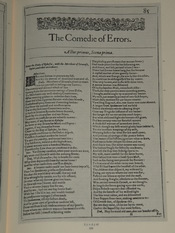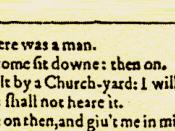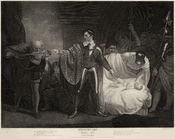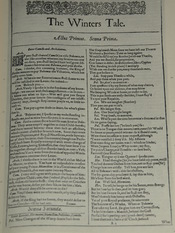Kakietek's study is the first attempt to provide a systematic and exhaustive description of the modal verbs in the language of Shakespeare. "He points out that the existing literature on the subject is appallingly poor and does not actually present any real value from the linguistic points of view" (P.Kakietek, 'Modal Verbs in Shakespeare's English Poznam, 1972, pag.3).The publication he lists contains nearly all the currently available concerning the problem: E. A. Abbott, "A Shakesperian Grammar", 1925,pag 210-234; W. Franz, "Die Sprache Shakespeare", 1948, pag.174-180 e pag.475-502;Frieden "Studies on the Tenses of the English Verb from Chaucer to Shkespeare", 1948, pag.118-203; O Jespersen, "A Modern English Grammar", 1931, pag. 235-300; M. Ehrman, "The Meanings of the Modals in THE Present-Day America English", 1966, Appendix A, pag.78-97.
In Kakietek 'opinion, there is no doubt about the fact that the value of Ehrman's account is by far more important than that of the other works mentioned.
As the title of her book indicates, Ehrman is primarly concerned with the modals in Present-Day American English. Though her study of Shakespeare's modals is, is in fact, based on a fairly corpus amounting up to about 75.000 words according to Kakietek, the impression one receives is that it was carried out quite hastly and that the subject was treated by her as of secondary importance. As he mantains, "our impression seems to well be sub-stantiated by the fact that Ehrman's presentation is guilty of a number of factual mistakes as it leaves many things quite unexplained". Her theory of modal verbs in general is the subject of a detailed study made by Kakietek in chapter 1 of his own work. According to him the above mentioned works (except for Ehrman's) suffer from at least two weaknesses: 1) 'Wrong interpretation of the data' 2) 'Lack of desirable generalization regarding the modal verbs'.
Clearly this is a direct result of the inability on the part of the grammarians to keep apart two basically different things, namely, the semantics strictly pertaining to the modals and the semantics represented by the other sentential elements.(P. Kakietek, "Modal Verbs in Shakespeare's English, pag 1).Kakietek's study is based on the material collected from ten of Shakespeare's plays: All's Well That Ends Well, The Comedy of Errors, Henry IV part One and part Two, Henry V, Julius Caesar, Macbeth, Measure for Measure, Othello and The Winter's Tale. Following Anderson (in his work:"Some Proposal Concening The Modal Verbs in English", Journal of Linguistics, 6, 1970, pag. 75)Kakietek obseves that each modal can be assigned one or more interpretation, each decomposable into a set of meaning components or features.This is how the overlap between MAY and CAN is visualized in the following figure: --M-- NON-INTENTIONAL POTENTIAL EXTERNAL NON-CONDITIONAL NON-PAST <__MAY__________ --M-- INTENTIONAL POTENTIAL EXTERNAL NON-CONDITIONAL NON-PAST CAN > --M-- INTENTIONAL POTENTIAL NON-EXTERNAL NON-CONDITIONAL NON-PAST Thus MAY and CAN are regarded as synonymous. They are alternativa manifestations of the same interpretation. For instance it is attributed to MAY and CAN two features, that is , EXTERNAL and POTENTIAL. Therefore as they realize more than one interpretation, they are polysemous. It follows that a given interpretation which is associated with a particular modal verb may belong to several classes symultaneously, membership to anyone of the classes being dependent on the presence of a particular feature in tha set assigned to the modal interpretation involved. Each feature constitues one term in a binary opposition either MARKED or UNMARKED. When the modals MAY CAN WILL MUST combine with the perfect auxiliary HAVE, an INTENTIONAL interpretation for any of them is rendered impossible. So, in the following example MAY CAN WILL must receive an UNINTENTIONAL interpretation. Examples : 'He MAY HAVE ARRIVED at six' 'He CAN HAVE GONE by then' 'He'LL HAVE SEEN the British Museum' 'He MUST HAVE LEFT the town' The subclassification of the modals could thus be presented in the terms of a set of rules which would consist of subcategorization for VP and adding to it various terminal features. It is assumed here that all the modals are predicitve. Prediction simply means that the assurance of the action is expressed by the main verb. The feature INTENTIONAL is connected with the modal that combines with a verb denoting an action performed by animate agents, either dependent on themseves or on somebody/something else. By definition, then, modals appearing in sentences containig inanimate nouns as their subjects will be characterized by the lack of the feature INTENTIONAL.In the following examples the INTENTIONAL interpretation for the modal is excluded: 'Wood will float on water' 'It will get dark (before they finish the game)'.
These two instances are simply predictive.Moreover, INTENTIONAL modals tend to occur in sentences which carry meaning such a VOLITION, DETERMINATION, ABILITY, PERMISSION, OBLIGATION, etc.The feature INTENTIONAL will be also incompatible with what are called uncontrollable actions, ie, actions being outside human control which are denoted by the following verbs: DIE, EXIST, SNOPE, etc.The feature EXTERNAL will be assigned to those modals which appear in sentences in which an external agent is suggested. In 'Shall I bring it here?'the initiation of the subject and in this case depends upon the addressee. It turns out that the modal MUST is ambiguous with the respect to this particular destination.For instance, in 'He must leave early in the morning' the action may be or may not be dependent upon another person's will.I may add more details and examples but this is an essay and surely I must be brief. Thus to conclude it, I may say that Kakietek after specific research into the use of modal verbs in Shakespeare's works, concentrated above all on the use of the auxiliaries WILL/SHALL (WOULD/SHOULD), these are the ones most frequently and most commonly used. In fact, these forms are seen as future with the aspect of promise, command, moral obligation dependent on external circumstances such as laws, rules, etc. There is also the future of intention dependent on the intention of the subject of the sentence or of the speaker. Thus the external agent, which could obviously be animate or inanimate, is present. In any case, the predictive future is to be considered merely UNINTENTIONAL, as it cannot normally depend on the will of the subject/speaker of the sentence.





